ICSE Biology Previous Year Question Paper 2011 Solved for Class 10
ICSE Paper 2011 BIOLOGY
SECTION-I (40 Marks)
(Attempt all questions from this Section)
Question 1:
(a) Name the following :
(i) The mineral element essential for the clotting of blood.
(ii) The cells of the testes that produce male hormones.
(iii) The nutritive layer of the eye which also prevents reflection of light.
(iv) The structural and functional unit of the kidney.
(v) That part of the chloroplast where the light reaction of photosynthesis takes place. [5]
(b) State the main function of the following :
(i) Yellow spot. (ii) Coronary artery (iii) Medulla oblongata (iv) Thrombocytes (v) Vitreous humour [5]
(c) Copy and complete the following by filling in the blanks 1 to 5 with appropriate words/terms Iphrases :
To test the leaf for starch, the leaf is boiled in water to ………. (1). It is next boiled in methylated spirit to ………. (2). The leaf is placed in warm water to soften it. It is then placed in a dish and ………. (3) solution is added. The region, which contains starch, turns ………. (4) and the region, which does not contain starch, turns ………. (5). [5]
(d) Give the exact location of:
(i) Hydathodes
(ii) Organ of corti
(iii) Mitral valve
(iv) Pituitary gland
(v) Amnion. [5]
(e) State whether the following statements are true or false. If false rewrite the correct form of the statement by changing the first or last word only.
(i) Lysosomes is a part of the cell in which chromosomes are present.
(ii) Urethra carries urine from kidney to the urinary bladder.
(iii) Centromere is the organelle of the cell that initiates cell division.
(iv) Gestation is the process of fixing of the zygote to the uterine wall.
(v) Pencillin obtained from Pencillium notatum is an antibody. [5]
(f) Rewrite the complete the following sentences by inserting the correct word in the space indicated:
(i) ………. vaccine is given to build up immunity against polio.
(ii) Phenotype is the observable characteristic which is ………. controlled.
(iii) Wooden doors swell up in rainy season due to ………. .
(iv) The blood vessel that begins and ends in capillaries is the ………. .
(v) ………. is the phenomenon of contraction of the cytoplasm from the cell wall. [5]
(g) Study the following diagram carefully and then answer the questions that follow:
 (i) Name the cell labelled 1.
(i) Name the cell labelled 1.
(ii) Identify the phenomenon occurring in A.
(iii) Mention two structural differences between 1 and 2.
(iv) Name the process occurring m B and C and state the importance of this process in the human body. [5]
(h) Match the items in Column I with that which is most appropriate in Column II.
| Column I | Column II |
| (1) Pacemaker | (a) Associated with static body balance |
| (2) Stroma | (b) Chordae tendinae |
| (3) Afferent nerve | (c) Site of light reaction |
| (4) Prolactin | (d) Motor neuron |
| (5) Saccules | (e) S A node |
| (f) Stimulates production of milk by the mammary gland | |
| (g) Site of dark reaction | |
| (h) Transmits impulses from receptor organ to spinal ftord. | |
| (i) Secreted by unterior, tube of Pituitary gland | |
| (j) Transfers impulses from spinal cord to muscles |
Answer:
(a) (i) Calcium
(ii) Interstitial cells
(iii) Choroid
(iv) Nephron
(v) Grana
(b) (i) Is the area of best vision as it has maximum no. of cone cells and perceieves image in the best manner.
(ii) Supplies oxygenated blood to the walls of heart.
(iii) Controls the involuntary activities of the body.
(iv) Helps in blood clotting by producing thromboplastio.
(v) Jelly like substance giving round shape to eye ball.
(c) (1) kill the cells, (2) remove chlorophyll, (3) iodine, (4) blue black, (5) brown.
(d) (i) On the margins of leaves of some plants.
(ii) In the endolymph present in the middle dual of cochlea.
(iii) Between left amide and left ventricle
(iv) At the base of midbrain.
(v) Around the embryo in the uterus.
(e) (i) False; Nucleus is a part of the cell in which chromosomes are present.
(ii) False; Ureter carries urme from kidney to the urinary bladder.
(iii) False; Centrosome is the organelle of the cell that initiates cell division.
(iv) False; Implantation is the process of fixing of the zygote to the uterus wall.
(v) False; Pencillm obtained from Pencillium notatum is an antibiotic.
(f) (i) Salk’s vaccine is given to build up immunity against polio.
(ii) Phenotype is the observable characteristic which is genetically controlled.
(iii) Wooden doors swell up in rainy season due to imbibition.
(iv) The blood vessel that begins and ends in capillaries is the hepatic portal system.
(v) Plasmolysis is the phenomenon of contraction of the cytoplasm hern cell wall.
(g) (i) 1-Red blood cells.
(ii) Diapedesis
(iii)
| 1 | 2 |
| (a) Biconcave in shape (b) Nucleus absent | Amoeboid in shape Nucleus present |
(iv) Phagocytosis Process. By this process the WBC engulfs the diseases causing germs that enter the body and thus defend our body.
(h)
| Column 1 | Column II |
| (1) Pacemaker | (e) S A node |
| (2) Stroma | (c) Site of light reaction |
| (3) Afferent nerve | (h) Transmits impulses from receptor organ to spinal cord. |
| (4) Prolactin | (f) Stimulates production of milk by the mammary gland |
| (5) Saccules | (a) Associated with static body balance |
SECTION-II (40 Marks)
(Attempt any Four questions from this Section)
Question 2:
(a) Study the diagram given below and then answer the questions that follow :
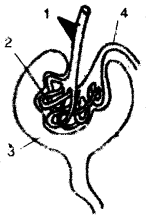 (i) Name the region is the kidney where the above structure is present ?
(i) Name the region is the kidney where the above structure is present ?
(ii) Name the parts labelled 1, 2, 3 and 4.
(iii) Name the stages involved in the formation of urine
(iv) What is the technical term given to the process occurring in 2 and 3 ? Briefly describe the process. [5]
(b) Give reasons for the following :
(i) Photosynthesis is considered as a process supporting all life on earth.
(ii) A matured mammalian erythrocyte lacks nucleus and mitochondria.
(iii) Potato cubes when placed in water become firm and increase in size.
(iv) Urine is slightly thicker in summer than in winter.
(v) People living in hilly regions usually suffer from simple goitre. [5]
Answer:
(a) (i) Cortex
(ii) 1 – Afferent arteriole
2 – Glomerulus
3 – Bowman’s capsule
4 – Efferent arteriole
(iii) Ultrafiltration Selective reabsorption Tubular secretion
(iv) Ultrafiltration.
Blood rich in nitrogenous waste and excess water enters Bowmans Capsule through a wider afferent arteriole then splits into fine capillaries called glomerulus due to which a hydrostatic pressure is created. This pressure leads to filtration of water with nitrogenous wastes.
(b) (i) Photosynthesis process leads to release of oxygen which is essential for all life on earth. It also produces food for all heterotrophs.
(ii) Lack of nucleus helps in having more surface area for absorption and transport of oxygen.
Lack of mitochondria helps in the way that RBC would not consume any oxygen that it is transporting.
(iii) Water is a hypotonic medium, so endosmosis occurs due to which water enters into potato cells making them firm and larger in size i.e., making them turgid.
(iv) In summer, body loses large amount of water by perspiration or direct evaporation. So blood is order to maintain its osmotic concentration reabsorbs large amount of water from the tubules of Nephron due to which there is less water left to be released as urine. So urine becomes thicker whereas in winter, there is less reabsorption. So thin urine is passed.
(v) In hilly areas there is scarcity of iodine in the soil and in their diet. Deficiency of iodine leads to simple goitre.
Question 3:
(a) Study the diagram given below and then answer the questions that follow :
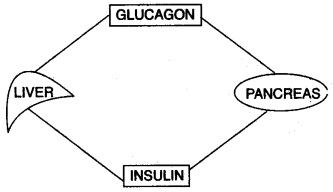 (i) Name the cells of the pancreas that produce (1) glucagon (2) insulin.
(i) Name the cells of the pancreas that produce (1) glucagon (2) insulin.
(ii) State the main function of (1) glucagon (2) insulin.
(iii) Why is the pancreas referred to as an exo-endocrine gland ?
(iv) Why is insulin not given orally but is injected into the body ?
(v) What is the technical term for the cells of the pancreas that produce endocrine hormones ?
(vi) Where in the body is the pancreas located ? [5]
(b) With reference to the functioning of the eye, answer the questions that follow :
(i) What is meant by power of accommodation of the eye ?
(ii) What is the shape of the lens during (1) near vision. (2) distant vision ?
(iii) Name the two structures in the eye responsible for bringing about the change in the shape of the lens.
(iv) Name the cells of the retina and their respective pigments which get
activated (1) in the dark (2) in light. [5]
Answer:
(a) (i) (1) Glucagon—Produced in alpha cells of pancreas.
(2) Insulin—Produced in beta cells of pancreas.
(ii) (1) Glucagon—It helps to convert glycogen to glucose when blood glucose level falls.
(2) Insulin—It helps to convert excess glucose to glycogen when there is higher level of glucose in blood.
(iii) It is both exocrine as well as endocrine gland. As exocrine, it secretes pancreatic juice containing digestive enzymes and pour them into duodenum part of intestine through pancreatic duet. As endocrine, it secretes hormones like insulin, glucagon and somatostatin and pour them directly into blood.
(iv) Insulin is a protein by composition so if it is given orally it will get digested in the stomach and will not be able to perform its function.
(v) Islets of Langerhans.
(vi) In the abdomen in the loop of small intestine close to duodenum part of small intestine.
(b) (i) The alteraction in thickness of lens that enables us to see objects at varying distances is called accomodation.
1. During near vision the shape of the lens is more convex or rounded.
2. During distant vision the shape of the lens is less convex or flat.
(iii) Ciliary muscles and suspensory ligament.
(iv) 1. In the dark — The cells are rods in pigment is rhodopsin.
2. In the light — The cells are cones the pigment is lodopsin.
Question 4:
(a) The diagram alongside represents circulation in the human body. Answer the questions that follow :
 (i) Name the blood vessels labelled 1, 3, 6, and 7.
(i) Name the blood vessels labelled 1, 3, 6, and 7.
(ii) Name the blood vessel that supplies the walls of the heart with oxygen.
(in) Draw a neat labelled diagram of the blood vessel numbered ‘2’ as seen in a cross section.
(iv) Mention one structural difference between blood vessels numbered 4 and 5. [5]
(b) With reference to the human ear, answer the questions that follow :
(i) Give the technical term for the str ucture found in the inner ear.
(ii) Name the three small bones present in the middle ear. What is the biological term for them collectively ?
(iii) Name the part of the ear associated with (1) static balance (2) hearing (3) dynamic balance.
(iv) Name the nerve, which transmits messages from the ear to the brum. [5]
Answer:
(a) (i) 1 – Pulmonary vein,
3 – Hepatic portal vein,
6 – Hepatic vein
7 – Posterior vena cava.
(ii) Coronary artery
(iii)
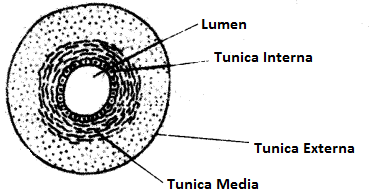
(iv)
| 4 (Renal artery) | 5 (Renal vein) |
| 1. Thick muscular wall 2. Narrow lumen 3. Valves absent | Thin muscular wall Wide lumen Valves present |
(b) (i) Membranous labyrinth
(ii) Hammer anvil and stirrup or Malleus incus and stapes
Collectively called Ear ossicles.
(iii) CD Static balance: Utriculus and sacculus
(2) Hearing: Cochlea
(3) Dynamic balance: Semicircular canals
(iv) Auditory nerve
Question 5:
(a) The diagram below represents two reproductive cells A and B. Study the same and than answer the questions that follow :
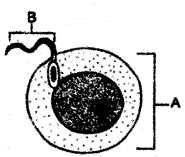 (i) Identify the reproductive cells A and B.
(i) Identify the reproductive cells A and B.
(ii) Name the specific part of the reproductive system where the above cells are produced.
(iii) Where in the female reproductive system to these cells unite ?
(iv) Name the main hormones secreted by the (1) ovary (2) testes.
(v) Name an accessory gland found in the male reproductive system and state the function of its secretion. [5]
(b) The diagram below represents a layer of epidermal cells showing a fully-grown root hair. Study the diagrami and answer the questions that follow :
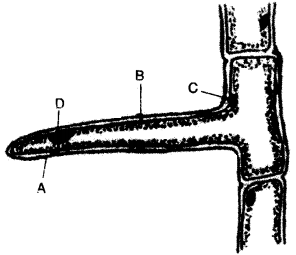 (i) Name the parts labelled A, B, C and D.
(i) Name the parts labelled A, B, C and D.
(ii) The root hair cell is in a turgid state Name and explain the process that caused this state.
(iii) Mention one distinct difference between the parts labelled A and B.
(iv) Draw a diagram of the above root hair cell as it would appear when a added near it.
Answer:
(a) (i) A – Ovum
B – Sperm
(ii) Ovum is produced from the germinal layers in the ovary Sperm is produced from seminiferous tubules in the testis
(iii) In the fallopian tube
(iv) (1) Hormone by ovary: Oesterogen and progesteron (2) Hormone by testes: Testosterone.
(v) Seminal Vesicle. Secretes seminal fluid. It contains fructose which gives energy to the sperm.
(b) (i) A – Cell wall of root hair.
B – Cell membrane of root hair
C – Cytoplasm
D – Nucleus
(ii) The soil medium is hypotonic. So endosmosis occur due to which the root hair cell turns turgid.
(iii)
| A (Cell wall) | B (Cell membrane) |
| Is freely permeable | Is semi permeable |
(iv)

Question 6:
(a) The diagram below represents a stage during cell division. Study the same and than answer the questions that follow:
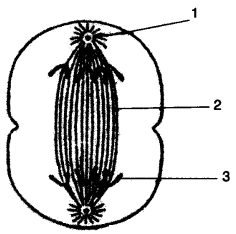 (i) Name the parts labelled 1, 2 and 3.
(i) Name the parts labelled 1, 2 and 3.
(ii) Identify the above stage and give a reason to support your answer.
(iii) Mention where m the body this type of cell division occurs.
(iv) Name the stage, prior to this stage and draw a diagram to represent the same. [5]
(b) Study the diagram given below and answer the questions that follow :
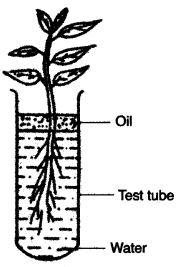 (i) Name the process being studied in the above experiment.
(i) Name the process being studied in the above experiment.
(ii) Explain the process mentioned in (i) above.
(iii) Why is oil placed, over water ?
(iv) What do we observe with regard to the level of water when this set up is placed in (1) bright sunlight (2) humid conditions (3) windy day ?
(v) Mention any three adaptations found in plants to overcome the process mentioned in (ii) above. [5]
Answer:
(a) (i) 1 – Centriole
2 – Spindle fibre
3 – Chromatids
(ii) Anaphase, because the chromatids have split and are getting pulled towards the opposite poles.
(iii) In the somatic cells.
(iv) Metaphase

(b) (i) Transpiration
(ii) Is the process of lpss of water in the form of vapour from the aerial parts of the plant.
(iii) Oil placed over water to prevent direct evaporation of water.
(iv) 1. In bright sunlight — The level of water will fall faster.
2. In humid condition — The level of water will fall very slowly.
3. On windy day — The level of water falls faster.
(v) To reduce the rate of transpiration the plants adapts certain modefications.
1. The cuticle is very thick.
2. The leaves are absent or reduced to spines.
3. Stomata are covered by hair or Stomata located in pits.
Question 7:
(a) (i) During a street fight between two individuals, mention the effects on the following organs by the autonomous nervous system, in the table given below : (one has been done for you an an example).
| Organ | Sympathetic System | Para Sympathetic System |
| e.g. Lungs (1) Heart (2) Pupil of the eye (3) Salivary gland | Dilates bronchi and bronchioles | Constricts bronchi and bronchioles |
(ii) List four major activities of Red cross. [5]
(b) Write down the difference between the following pairs as indicated within the brackets:
(i) Antiseptic and disinfectant (an example for each)
(ii) Erythrocytes and leucocytes (function)
(iii) Guttation and bleeding in plants (cause)
(iv) NADP and AIDS (expand the abbreviation)
(v) Monohybrid and Dihybrid cross (phenotypic ratio). [5]
Answer:
(a) (i)
| Organ | Sympathetic System | Para Sympathetic System |
| (1) Heart | Beats faster | Returns to normal |
| (2) Pupil of the eye | Dialates | Constricts |
| (3) Salivary gland | Stimulates | Inhibits |
(ii) Four activities of the Red Cross :
1. Provides medical aid and relief to victims of natural calamities like flood, famine, earthquake etc.
2. Provide blood and medical aid to wounded soldiers during war.
3. Organize workshop to create awareness among people to prevent accidents.
4. Trans mid wives
(b) (i ) Antiseptic – Boric acid
Disinfectant – Lisol.
(ii) Erythrocytes – Transport respiratory gases
Leucocytes – Produce antibodies and protect the body from disease causing germs.
(iii) Guttation – Warm but humid weather and less transpiration.
Bleeding in plant – Injury in the cells of plant.
(iv) NADP – Nicotenamide Adenine Dinucleotide Phosphate
AIDS – Aquired Immuno Deficiency Syndrome.
(v) Monohybrid Cross – Phenotypic ratio of F2 generation = 3:1
3 – Dominant 1 – Recessive
Dihybrid Cross – Phenotypic ratio of F2 generation is 9 : 3 : 3 : 1
9- Dominant 3 – New combination
3 – New combination 1 – Recessive.
